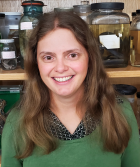Dr. Rachel Olson

Title: Assistant Professor
Dept/Program: Biology
Phone: 330-972-4342
Fax: 330-972-8445
Email: rolson@uakron.edu
Biography
My research program centers around 1) exploring the biomechanics of musculoskeletal systems, 2) interpreting form and function within an evolutionary framework, and 3) addressing biomedical problems using bioinspired approaches. To accomplish this, I apply a broad range of in vivo, comparative, and computational methods, using a diversity of animal models.
My most recent work is focusing on the biomechanics of sporting dogs. I have active projects funded by the American Kennel Club Canine Health Foundation and the American Association of Rehabilitation Veterinarians with collaborators from The Ohio State University College of Veterinary Medicine and Georgia Tech looking at agility dogs. I am looking to expand this work to cover a variety of other sporting and working dogs. This work utilizes motion capture, machine learning approaches to image analysis (e.g., DeepLabCut), and pressure mats to study the kinematics and kinetics of different behaviors.
The tongue is particularly interesting because of its unique anatomical and functional characteristics and its participation in a wide variety of tasks. For example, it is only partially reliant on an external skeletal support system and has no internal bony skeleton, yet it can perform highly complex movements and deformations contributing to a range of oral behaviors, from feeding to vocalizations. Furthermore, as a muscular hydrostat, deformation of the tongue in one dimension is compensated for in others without major changes in volume. Historically, these movements and deformations have been hard to quantify in vivo, however modern methods now make this possible. To test hypotheses about diet and tongue kinematics, I have taken an experimental and anatomical comparative approach that captures the high diversity in tongue morphology across mammals.
For feeding studies, I use marker-based X-ray Reconstruction of Moving Morphology (XROMM) to reconstruct the 3D movements of the tongue and jaw. From these kinematic datasets, I have demonstrated that lapping and sucking utilize different jaw kinematics and tongue deformations. This is important because it shows there are different mechanisms involved in fluid transport in mammals, with some species such as the pig showing elements of both. I have shown that there are differences in the timing of protraction-retraction of the tongue relative to the jaw in different behaviors, demonstrating differences in tongue-jaw coordination. My work indicates that the observed length and width changes at a regional level correlate with the corresponding muscle fiber anatomy of the tongue in that region. I demonstrated that regions of the tongue do not always show the expected trade-off in length and width deformations. My findings demonstrate that tongue movements and deformations are generally consistent with modeling the tongue as a muscular hydrostat, they also indicate that the tongue functions in a more complex way, with a broader range of possible deformations than predicted by classical morphological interpretations of muscular hydrostats alone. Thus a biomechanical model of the tongue created from a variety of data is necessary to understand how this complex muscular organ accomplishes its highly intricate movements.
Research Interests
Biomechanics, feeding, locomotion, soft-tissue, muscular hydrostat, tongue, anatomy, comparative, dog, canine
Education
BS Biological Sciences Youngstown State University
PhD Biological Sciences Ohio University
Publications
Olson RA, Montuelle SJ, Williams SH. (2023). Characterizing tongue deformations during mastication using changes in planar components of 3D angles. Phil Trans B, in press. https://doi.org/10.1098/rstb.2022.0555
Ramey C, Pechette Markley A, Olson RA, Herbet A, Lin V, Seitz B#, Jackson M. (2023) AGILE: AGility Innovations Leveraging Electronics. In Tenth International Conference on Animal-Computer Interaction (ACI’23), December 4–8, 2023, North Carolina State University, USA. ACM, New York, NY, USA
Olson RA, Montuelle SJ, Curtis H, Williams SH. (2021). Regional tongue deformations during chewing and drinking in the pig. Integr Org Biol 3:obab012. https://doi.org/10.1093/iob/obab012
Olson RA, Montuelle SJ, Chadwell BA, Curtis H, Williams SH. (2021). Jaw kinematics and tongue protraction-retraction during chewing and drinking in the pig. J Exp Biol 224:jeb239509. https://doi.org/10.1242/jeb.239509
Montuelle SJ, Olson RA, Beery SM, Curtis H, Williams SH. 2020. Effects of food properties on chewing in pigs: flexibility and stereotypy of jaw movements in a mammalian omnivore. PLOS One https://doi.org/10.1371/journal.pone.0228619
Montuelle SJ, Olson RA, Curtis H, Williams SH. 2020. Unilateral lingual nerve transection alters tongue-jaw coordination during mastication in pigs. J Appl Physiol 128:941-951. https://doi.org/10.1152/japplphysiol.00398.2019
Montuelle SJ, Olson RA, Curtis H, Sidote J, Williams SH. 2019. The effects of unilateral lingual nerve injury on the kinematics of mastication in pigs. Arch Oral Biol 98:226-237. https://doi.org/10.1016/j.archoralbio.2018.11.024
Montuelle SJ, Olson RA, Curtis H, Sidote J, Williams SH. 2018. Flexibility of feeding movements in pigs: effects of changes in food toughness and stiffness on the timing of jaw movements. J Exp Biol https://doi.org/10.1242/jeb.168088
Olson RA, Glenn ZD, Cliffe RN, Butcher MT. 2017. Architectural properties of sloth forelimb muscles (Pilosa: Bradypodidae). J Mammal Evol 25:573-588. https://doi.org/10.1007/s10914-017-9411-z
Olson RA, Womble MD, Thomas DR, Glenn ZD, Butcher MT. 2016. Functional morphology of the forelimb of the nine-banded armadillo (Dasypus novemcinctus): comparative perspectives on the myology of Dasypodidae. J Mammal Evol 23:49-69. https://doi.org/10.1007/s10914-015-9299-4
